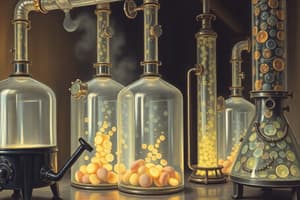Podcast
Questions and Answers
For the multiple reactions 2A + R 2R + S, if initially there are 2 moles of A present and the number of moles of A and R at equilibrium are 0.3 and 0.5 respectively, what is the number of moles of S present?
For the multiple reactions 2A + R 2R + S, if initially there are 2 moles of A present and the number of moles of A and R at equilibrium are 0.3 and 0.5 respectively, what is the number of moles of S present?
- 0.175 (correct)
- 0.125
- 0.225
- 0.333
If the rate constant of a chemical reaction increases by a factor of 100 when the temperature is raised from 400 K to 500 K, and assuming the transition state theory is valid, what is the approximate value of the activation energy ($E_a$) divided by the gas constant ($R$)?
If the rate constant of a chemical reaction increases by a factor of 100 when the temperature is raised from 400 K to 500 K, and assuming the transition state theory is valid, what is the approximate value of the activation energy ($E_a$) divided by the gas constant ($R$)?
- 8621 K
- 8784 K
- 9210 K (correct)
- 8987 K
In the reaction A + B R + S, where R is the desired product and S is an unwanted side product, which combination of reactant concentrations should be used to maximize the conversion of A to R?
In the reaction A + B R + S, where R is the desired product and S is an unwanted side product, which combination of reactant concentrations should be used to maximize the conversion of A to R?
- Any concentration of A, high concentration of B
- Low concentration of A, low concentration of B
- High concentration of A, any concentration of B
- High concentration of A, low concentration of B (correct)
Given the rate data for the reaction A + B C + D at different temperatures, what is the approximate activation energy ($E_a$) of this reaction?
Given the rate data for the reaction A + B C + D at different temperatures, what is the approximate activation energy ($E_a$) of this reaction?
For the reaction A B conducted in an isothermal batch reactor, if the conversion of A increases linearly with holding time, what is the order of the reaction?
For the reaction A B conducted in an isothermal batch reactor, if the conversion of A increases linearly with holding time, what is the order of the reaction?
At elevated temperatures, acetaldehyde (CH$_3$CHO) undergoes a gas-phase decomposition reaction. What are the products of this reaction?
At elevated temperatures, acetaldehyde (CH$_3$CHO) undergoes a gas-phase decomposition reaction. What are the products of this reaction?
In the reaction scheme: A + B R (desired product), with rate $r_1 = k_1 C_A C_B^2$, and A S (unwanted side product), with rate $r_2 = k_2 C_A$, which statement is correct?
In the reaction scheme: A + B R (desired product), with rate $r_1 = k_1 C_A C_B^2$, and A S (unwanted side product), with rate $r_2 = k_2 C_A$, which statement is correct?
A reversible reaction A + B C + D is carried out in a constant-volume batch reactor. Which of the following statements is true?
A reversible reaction A + B C + D is carried out in a constant-volume batch reactor. Which of the following statements is true?
In a consecutive reaction A B C, if the rate constant for the first step ($k_1$) is much larger than the rate constant for the second step ($k_2$), what can be said about the concentration of the intermediate species B?
In a consecutive reaction A B C, if the rate constant for the first step ($k_1$) is much larger than the rate constant for the second step ($k_2$), what can be said about the concentration of the intermediate species B?




